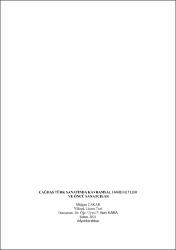| dc.contributor.advisor | Kara, F. Nuri | |
| dc.contributor.author | Çakar, Müjgan | |
| dc.date.accessioned | 2021-11-24T11:37:19Z | |
| dc.date.available | 2021-11-24T11:37:19Z | |
| dc.date.issued | 2021 | en_US |
| dc.date.submitted | 2021 | |
| dc.identifier.uri | https://hdl.handle.net/11630/9728 | |
| dc.description.abstract | Türkiye’de Cumhuriyetle başlayan çağdaşlaşma hareketleri ile geleneksel sanat alanının sınırları zorlanarak aşılmış ve yeni bir düşünce olgusu doğmuştur. Cumhuriyetin ilanından sonra reform ve yenilik sürecinin başlamasıyla sosyal, kültürel, politik, ekonomik ve sanat alanında köklü değişimler yaşanmaya başlanmıştır. Türkiye’de 1920’lerin başından günümüze kadar uzanan plastik sanatlara ilişkin gelişmelerde, çağdaşlaşma hareketleriyle biçimlenen özgür ve çağcıl felsefede temellenmektedir. Gerek tek partili dönem gerekse çok partili dönem içerisinde yaşanan düşün ve sosyal yaşam alanındaki tüm olgular Türk resim sanatının da kuramsal temellerini oluşturmuştur. Her ne kadar çağdaş Türk resim sanatının temelini Batı sanatının temel kavram, yöntem, teknik ve yaklaşımları oluştursa da yapıtlar bazında incelendiğinde Türk resim sanatında özde kendi toplumsal koşullar ve düşünce kaynaklarının sanatçı üzerinden bir yorumu öne çıkmaktadır. Bu bağlamda çağdaş Türk resim sanatının kuram-düşünce boyutunu başta 18. yüzyıl Batılılaşama hareketi, Ulu Önder Atatürk’ün önderliğinde gerçekleşen Milli Mücadele ve sonrası çağdaşlaşma hareketi, modernleşme hamleleri ve devrimler, 1950’lerde çok partili siteme geçiş, sanayileşme hamleleri, kırsaldan kente göç, ihtilaller ve askeri darbeler, liberal ekonomik politikalarla dışa açılma süreci, globalleşme vb. birçok gelişmenin sosyal yaşam ve düşündeki etkileri doğal olarak Türk resim sanatında da tekrarlanmıştır. Özellikle 1980’li yıllarda geleneksel tekniğe dayalı betimlemenin yerini, kuramsal söylemin almasıyla sanatsal anlatıda kavram ön plana çıkmış, 1980’lerden sonra Türkiye’de kavramsal sanat anlayışı yaygınlaşmıştır. Malzeme ve yöntem olarak sınır tanımayan sanatçılar tuvalin dışına çıkarak yeni yorumlamalar getirmiştir. Sanatçı, sanat eseri, müze ve galeriler sorgulanarak sınırlar aşılmaya çalışılmış, bu bağlamda kavramsal sanatta günlük hayattaki hazır nesneler resim ve heykelin yerini alarak yeni bir eğilim sürecine girilmiştir. | en_US |
| dc.description.abstract | Starting with the Republic forced the modernization movement in Turkey has exceeded the boundaries of traditional art and a new idea was born cases. With the start of the reform and innovation process after the proclamation of the Republic, radical changes began to occur in the field of social, cultural, political, economic and art. In developments related to plastic arts dating back to the early 1920s, today in Turkey, which are formed with the free movement of modernization and are based on modern philosophy. Both the single-party period and the multi-party period, all the phenomena in the field of thought and social life have formed the theoretical foundations of Turkish painting art. Although the basic concepts, methods, techniques and approaches of Western art form the basis of contemporary Turkish painting, when it is examined on the basis of works, an interpretation of its own social conditions and sources of thought through the artist comes to the fore in Turkish painting art. In this context, the theoretical-thinking dimension of contemporary Turkish painting art, especially the 18th Century Westernization Movement, the National Struggle and the post-modernization movement under the leadership of the Great Leader Atatürk, modernization moves and revolutions, the transition to the multi-party system in the 1950s, the industrialization moves, migration from the countryside to the city. , revolutions and military coups, liberal economic policies, globalization and so on. The effects of many developments on social life and dreams are naturally repeated in Turkish painting. Especially in the 1980s based on the location of the description of the conventional art, artistic narratives take the discourse theoretical concepts come to the fore, after the 1980s Conceptual art is widespread understanding in Turkey. Artists who know no boundaries in terms of materials and methods have brought new interpretations by going beyond the canvas. By questioning artists, works of art, museums and galleries, boundaries have been tried to be crossed, in this context, a new trend has been entered in Conceptual Art by replacing painting and sculpture with ready-made objects in daily life. | en_US |
| dc.language.iso | tur | en_US |
| dc.publisher | Afyon Kocatepe Üniversitesi Sosyal Bilimler Enstitüsü | en_US |
| dc.rights | info:eu-repo/semantics/openAccess | en_US |
| dc.subject | Çağdaş Türk Resmi | en_US |
| dc.subject | Modernizm | en_US |
| dc.subject | Postmodernizm | en_US |
| dc.subject | Kavsamsal Sanat | en_US |
| dc.title | Çağdaş Türk sanatında kavramsal hareketler ve öncü sanatçılar | en_US |
| dc.title.alternative | Conceptual movements and leading artists in contemporary Turkish art | en_US |
| dc.type | masterThesis | en_US |
| dc.department | Enstitüler, Sosyal Bilimler Enstitüsü, Sanat ve Tasarım Ana Bilim Dalı | en_US |
| dc.relation.publicationcategory | Tez | en_US |
| dc.contributor.institutionauthor | Çakar, Müjgan | |



















